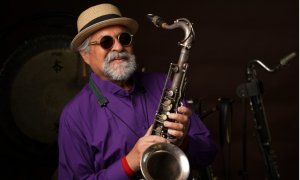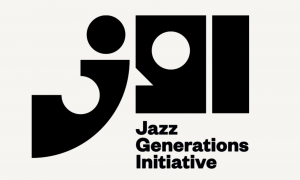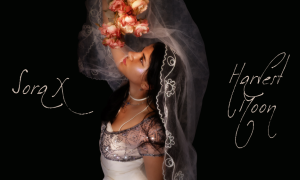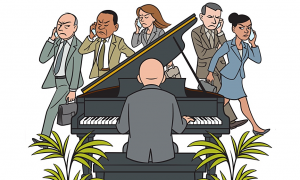Buddy Collette, a much in-demand Hollywood jazz and studio musician who appeared on 325 known recording sessions and courageously risked his burgeoning career to spearhead the merger of Los Angeles' segregated musicians' union locals in the early 1950s, died in L.A. on September 19. He was 89.
When I spoke to Buddy in July for my book, we talked at length about the segregated climate of Los Angeles in the 1940s and early 1950s, when sub-rosa real estate covenants between property owners and real estate brokers kept blacks from owning homes in the emerging and sprawling suburbs. Back then, the police also actively discouraged integration by pressuring clubs on Central Avenue and stopping vehicles occupied by blacks in white communities.
Despite working hard to carve out a career, Buddy risked everything while seeking fairness for black union musicians in the years just prior to the Supreme Court's Brown v. Board of Education decision in 1954. Like several other cities in the country, the American Federation of Musicians operated two locals in Los Angeles—one for blacks and one for whites.
Though separate, they were hardly equal. The black Local 767 was hugely dependent on the white Local 47 for work and for influence, which meant that the black local often wound up with the scraps just as the studio system was expanding there. Whites were called by contractors for a disproportionate share of the work, in part, because many had formal training and experience as sight-readers.
But as Buddy recollected during our conversations, once the union locals were united, the better black musicians replaced those white musicians who were on the job merely because they were friends of friends or knew the contractors. [Buddy Collette is pictured on the album cover just to the right of conductor Nelson Riddle, left]
Buddy's early key recordings as a sideman were in the late 1940s with Charles Mingus, a childhood friend, and in the early 1950s with Lyle “Spud" Murphy, who had developed a novel and sophisticated 12-tone system. These sideman recordings remain extraordinary.
When Chico Hamilton assembled a quintet and performed at The Strollers, a rough and tumble bar in Long Beach, CA, Buddy was invited to join by Chico, who had grown up near Buddy's grandmother's house.
Buddy told me how the group was formed:
“Chico started at The Strollers in the summer of 1955 but he didn't have the sound that he had in mind for the group. He had hired Bob Hardaway, a tenor saxophonist. That group played the Strollers for a week. Then Hardaway had to leave. When I arrived, I brought in four or five tunes, like Blue Sands, that were different. Chico liked the sound, but we weren't completely there yet. Something was missing. I could tell the group needed a different sound."
Buddy continued by relating a wonderful story about his inadvertent role in creating the original Chico Hamilton Quintet's signature sound:
“Fred Katz originally played piano with the group and then cello on the breaks. But Fred had a tendency to stay on stage too long during the breaks. Once he got going with the bow, there was no stopping him. One night he stayed too long, for 45 minutes or so, lost in thought while playing. Chico didn't like that. I said to Chico, 'Let's sneak on and start'—meaning me, Chico, bassist Carson Smith and guitarist Jim Hall. We got past Fred easily enough. He was still on the step to the bandstand lost in his own world. The piano where Fred was supposed to be was in the back but my horn was up front. I'm the lead player so I needed to be where people could see me.
“Everyone got in their place on stage. Then Chico started playing the drums, and Fred finally snapped out of it. But Fred couldn't get to the piano fast enough. We were all there and were starting to play. So Fred started bowing something and I played something on the flute. We didn't have a pianist but we did have a guitarist in Jim Hall that no one can beat. When Fred had played the piano, we couldn't really hear him anyway. As we played, Jim left space for the cello. That's why the group's sound was no one's idea. It just happened by accident, as a prank that turned into a sound we all dug immediately."
Buddy's first leadership date was Man of Many Parts (1956) which featured him on alto and tenor saxophones and flute. On albums that followed, Buddy recorded on 10 different instruments, including the clarinet. In fact, during the 1950s, Buddy often recorded several albums a month as a leader or sideman. His jazz output does not include his prolific movie studio or pop recording work, which are largely undocumented.
Buddy took jazz playing, composing, arranging and studio work seriously, developing a reputation in Hollywood as a disciplined ironman and highly dependable reed and woodwind player. He also was an awfully nice guy. I miss Buddy.
JazzWax note: For more on Buddy Collette, see my five-part interview here.
JazzWax tracks: Here are my 10 favorite Buddy Collette albums:
JazzWax clip: Here's Buddy on baritone sax with John Graas on Jazz Studio 3 for Decca in 1957. The musicians were Conte Candoli (trumpet), John Graas (French horn), Red Callender (tuba), Art Pepper (alto sax), Bob Cooper (tenor sax), Buddy Collette (baritone sax), Paul Moer (piano), Red Mitchell (bass) and Shelly Manne (drums)...
When I spoke to Buddy in July for my book, we talked at length about the segregated climate of Los Angeles in the 1940s and early 1950s, when sub-rosa real estate covenants between property owners and real estate brokers kept blacks from owning homes in the emerging and sprawling suburbs. Back then, the police also actively discouraged integration by pressuring clubs on Central Avenue and stopping vehicles occupied by blacks in white communities.
Despite working hard to carve out a career, Buddy risked everything while seeking fairness for black union musicians in the years just prior to the Supreme Court's Brown v. Board of Education decision in 1954. Like several other cities in the country, the American Federation of Musicians operated two locals in Los Angeles—one for blacks and one for whites.
Though separate, they were hardly equal. The black Local 767 was hugely dependent on the white Local 47 for work and for influence, which meant that the black local often wound up with the scraps just as the studio system was expanding there. Whites were called by contractors for a disproportionate share of the work, in part, because many had formal training and experience as sight-readers.
But as Buddy recollected during our conversations, once the union locals were united, the better black musicians replaced those white musicians who were on the job merely because they were friends of friends or knew the contractors. [Buddy Collette is pictured on the album cover just to the right of conductor Nelson Riddle, left]
Buddy's early key recordings as a sideman were in the late 1940s with Charles Mingus, a childhood friend, and in the early 1950s with Lyle “Spud" Murphy, who had developed a novel and sophisticated 12-tone system. These sideman recordings remain extraordinary.
When Chico Hamilton assembled a quintet and performed at The Strollers, a rough and tumble bar in Long Beach, CA, Buddy was invited to join by Chico, who had grown up near Buddy's grandmother's house.
Buddy told me how the group was formed:
“Chico started at The Strollers in the summer of 1955 but he didn't have the sound that he had in mind for the group. He had hired Bob Hardaway, a tenor saxophonist. That group played the Strollers for a week. Then Hardaway had to leave. When I arrived, I brought in four or five tunes, like Blue Sands, that were different. Chico liked the sound, but we weren't completely there yet. Something was missing. I could tell the group needed a different sound."
Buddy continued by relating a wonderful story about his inadvertent role in creating the original Chico Hamilton Quintet's signature sound:
“Fred Katz originally played piano with the group and then cello on the breaks. But Fred had a tendency to stay on stage too long during the breaks. Once he got going with the bow, there was no stopping him. One night he stayed too long, for 45 minutes or so, lost in thought while playing. Chico didn't like that. I said to Chico, 'Let's sneak on and start'—meaning me, Chico, bassist Carson Smith and guitarist Jim Hall. We got past Fred easily enough. He was still on the step to the bandstand lost in his own world. The piano where Fred was supposed to be was in the back but my horn was up front. I'm the lead player so I needed to be where people could see me.
“Everyone got in their place on stage. Then Chico started playing the drums, and Fred finally snapped out of it. But Fred couldn't get to the piano fast enough. We were all there and were starting to play. So Fred started bowing something and I played something on the flute. We didn't have a pianist but we did have a guitarist in Jim Hall that no one can beat. When Fred had played the piano, we couldn't really hear him anyway. As we played, Jim left space for the cello. That's why the group's sound was no one's idea. It just happened by accident, as a prank that turned into a sound we all dug immediately."
Buddy's first leadership date was Man of Many Parts (1956) which featured him on alto and tenor saxophones and flute. On albums that followed, Buddy recorded on 10 different instruments, including the clarinet. In fact, during the 1950s, Buddy often recorded several albums a month as a leader or sideman. His jazz output does not include his prolific movie studio or pop recording work, which are largely undocumented.
Buddy took jazz playing, composing, arranging and studio work seriously, developing a reputation in Hollywood as a disciplined ironman and highly dependable reed and woodwind player. He also was an awfully nice guy. I miss Buddy.
JazzWax note: For more on Buddy Collette, see my five-part interview here.
JazzWax tracks: Here are my 10 favorite Buddy Collette albums:
- Lyle “Spud" Murphy: New Orbits in Sound (1954)
- Chico Hamilton: Live at the Strollers (1955)
- Red Callender: Swingin' Suite (1955)
- Music to Listen to Barney Kessel By (1956)
- Man of Many Parts (1956)
- Tanganyika Jazz (1956)
- John Graas: Jazz Studio 3 (1957)
- Flute Fraternity (1957)
- Jazz Loves Paris (1958)
- Buddy and the Four Swinging Shepherds (1958)
JazzWax clip: Here's Buddy on baritone sax with John Graas on Jazz Studio 3 for Decca in 1957. The musicians were Conte Candoli (trumpet), John Graas (French horn), Red Callender (tuba), Art Pepper (alto sax), Bob Cooper (tenor sax), Buddy Collette (baritone sax), Paul Moer (piano), Red Mitchell (bass) and Shelly Manne (drums)...
This story appears courtesy of JazzWax by Marc Myers.
Copyright © 2025. All rights reserved.




























